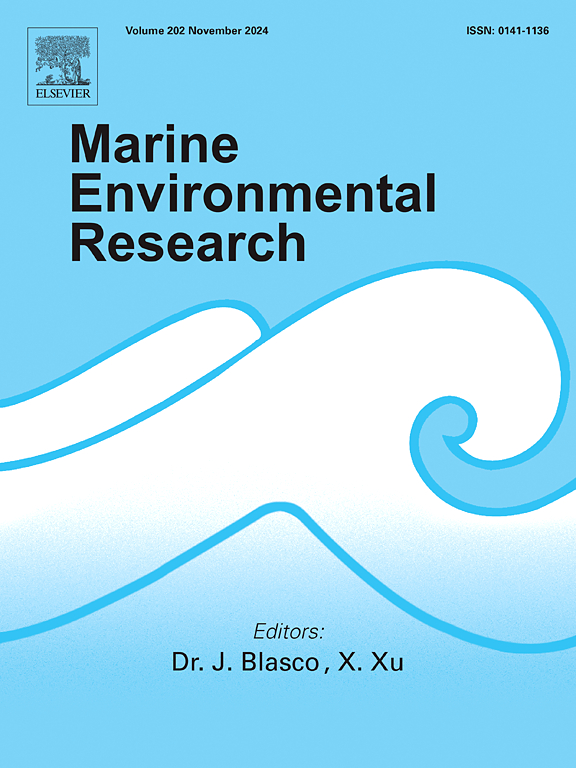易危巴西鹦嘴鱼种群的连通性
IF 3.2
3区 环境科学与生态学
Q2 ENVIRONMENTAL SCIENCES
引用次数: 0
摘要
鹦嘴鱼是热带和亚热带标志性的珊瑚礁鱼类,在那里它们消耗初级生产者并促进珊瑚礁生物侵蚀。尽管鹦嘴鱼具有重要的生态意义,但它们已受到全球过度捕捞的威胁。因此,了解鹦嘴鱼的遗传多样性和连通性模式对于确定保护重点和指导管理策略至关重要。本研究对两种巴西特有的脆弱鹦嘴鱼(Sparisoma frondosum和S. axillare)的遗传多样性、连通性和基因流进行了分析。在巴西沿海(00°50′s 44°15′w ~ 27°30′s 48°31′w)共采集到frondosum标本104份,axillare标本173份。通过对花楸11个微卫星位点和花楸16个微卫星位点的分析,我们发现Ho <;他;S. frondosum分布在里约热内卢de Janeiro州(RJ)的亚热带珊瑚礁附近,S. axillare分布在孤立的Trindade和Martim Vaz群岛(IT)。遗传分化与地理距离无显著相关,表明空间距离以外的其他因素对其遗传结构的形成起着重要作用。这两个物种对海洋屏障的反应不同,并且根据过度捕捞如何影响遗传连通性来讨论观察到的模式。沿海种群需要沿着巴西海岸进行协调管理,而遥远岛屿和南部范围的遗传结构突出了连通性的限制和对环境变化的潜在脆弱性。本文章由计算机程序翻译,如有差异,请以英文原文为准。
Population connectivity of vulnerable Brazilian parrotfishes
Parrotfishes are iconic tropical and subtropical reef fishes, where they consume primary producers and contribute to reef bioerosion. Despite their ecological importance, parrotfishes have been threatened by overfishing worldwide. Understanding patterns of genetic diversity and connectivity is therefore essential for identifying conservation priorities and guiding management strategies for parrotfishes. Here, we evaluated the genetic diversity, connectivity, and gene flow of Sparisoma frondosum and S. axillare, two vulnerable and endemic Brazilian parrotfishes. A total of 104 samples of S. frondosum and 173 of S. axillare were collected along the Brazilian coast (from 00°50′S 44°15′W to 27°30′S 48°31′W). By assessing 11 microsatellite loci in S. frondosum and 16 in S. axillare, we found Ho < He; with strong structuring near the southern end of its distribution at the subtropical reefs of Rio de Janeiro state (RJ) for S. frondosum, and in the isolated Trindade and Martim Vaz Archipelago (IT) for S. axillare. No significant correlation was found between genetic differentiation and geographical distance, suggesting that factors other than spatial distance play key roles in shaping their genetic structures. Both species respond differently to marine barriers, and the observed patterns were discussed in light of how overfishing may be influencing genetic connectivity. Coastal populations require coordinated management along the Brazilian coast, while the genetic structuring in distant islands and at the southern range limits highlights connectivity constraints and potential vulnerability to environmental change.
求助全文
通过发布文献求助,成功后即可免费获取论文全文。
去求助
来源期刊

Marine environmental research
环境科学-毒理学
CiteScore
5.90
自引率
3.00%
发文量
217
审稿时长
46 days
期刊介绍:
Marine Environmental Research publishes original research papers on chemical, physical, and biological interactions in the oceans and coastal waters. The journal serves as a forum for new information on biology, chemistry, and toxicology and syntheses that advance understanding of marine environmental processes.
Submission of multidisciplinary studies is encouraged. Studies that utilize experimental approaches to clarify the roles of anthropogenic and natural causes of changes in marine ecosystems are especially welcome, as are those studies that represent new developments of a theoretical or conceptual aspect of marine science. All papers published in this journal are reviewed by qualified peers prior to acceptance and publication. Examples of topics considered to be appropriate for the journal include, but are not limited to, the following:
– The extent, persistence, and consequences of change and the recovery from such change in natural marine systems
– The biochemical, physiological, and ecological consequences of contaminants to marine organisms and ecosystems
– The biogeochemistry of naturally occurring and anthropogenic substances
– Models that describe and predict the above processes
– Monitoring studies, to the extent that their results provide new information on functional processes
– Methodological papers describing improved quantitative techniques for the marine sciences.
 求助内容:
求助内容: 应助结果提醒方式:
应助结果提醒方式:


